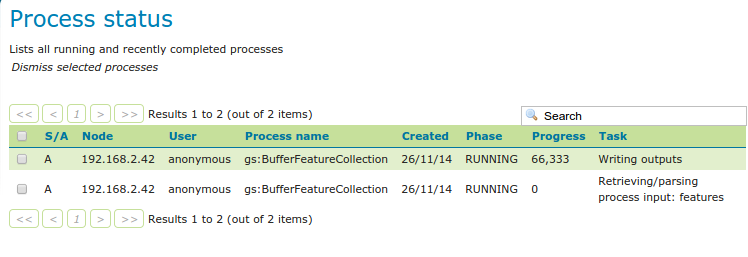WPS Service page¶
The Web Processing Service (WPS) page supports the basic metadata for the service, as well as service specific settings
Service Metadata¶
The service metadata section is common among all services. See the section on Service Metadata.

Execution and resource management options¶

Execution settings:
Connection timeout: the number of seconds the WPS will wait before giving up on a remote HTTP connection used to retrieve complex inputs
Maximum synchronous executions run parallel: the maximum number of synchronous processes that will run in parallel at a given time. The others will be queued.
Maximum execution time for synchronous requests: the maximum time a synchronous process is allowed executing. Processes running in synchronous mode will have to complete execution within the set time limit, or they will be dismissed automatically. These requests have the client waiting for a response on a HTTP connection, so choose a relatively short time (e.g., 60 seconds)
Maximum queue and execution time for synchronous requests: the maximum time a process is allowed in the queue and executing. Processes running in synchronous mode will have to complete within the set time limit, or they will be dismissed automatically. These requests have the client waiting for a response on a HTTP connection, so choose a relatively short time (e.g., 60 seconds)
Maximum asynchronous executions run parallel: the maximum number of asynchronous processes that will run in parallel at a given time. The others will be queued
Maximum execution time for asynchronous requests: the maximum time an asysynchronous process is allowed executing. Processes running in asynchronous mode will have to complete within the set time limit, or they will be dismissed automatically
Maximum queue and execution time for asynchronous requests: the maximum time an asysynchronous process is allowed in the queue and executing. Processes running in asynchronous mode will have to complete within the set time limit, or they will be dismissed automatically
Resource settings:
Resource expiration timeout: number of seconds the result of a asynchronous execution will be kept available on disk for user to retrieve. Once this time is expired these resources will be eligible for clearing (which happens at regular intervals).
Resource storage directory: where on disk the input, temporary and output resources associated to a certain process will be kept. By default it will be the
temp/wpsdirectory inside the GeoServer data directoryExternal output directory: Some processes allow execution outputs to be stored in an external output directory (not subject to
Resource expiration timeout). To enable this functionality provide a path to external storage with the understanding that you are responsible for managing the contents of this folder. Leave empty to disable writing outside of the resource storage.
Process status page¶
The process status page, available in the “About & Status” section, reports about running, and recently completed, processes:

The table contains several information bits:
S/A: synchronous or asynchronous execution
Node: the name of the machine running the process (important in a clustered environment)
User: user that started the execution
Process name: the main process being run (chained processes will not appear in this table)
Created: when the process got created
Phase: the current phase in the process lifecycle
Progress: current progress
Task: what the process is actually doing at the moment
In GeoServer there are the following execution phases:
QUEUED: the process is waiting to be executed
RUNNING: the process is either retrieving and parsing the inputs, computing the results, or writing them out
FAILED: the process execution terminated with a failure
SUCCESS: the process execution terminated with a success
DISMISSING: the process execution is being dismissed, depending on the process nature this might take some time, or be instantaneous
All executions listed in the table can be selected, and then dismissed using the “Dismiss selected processes” link at the top of the table. Unlike the “Dismiss” vendor operation this UI allows to also dismiss synchronous processes. Once the process dismissal is complete, the process execution will disappear from the table (in accordance with the WPS specification).
Completed processes can also be dismissed, this will cause all on disk resources associated to the process to be removed immediately, instead of waiting for the regular time based expiration.